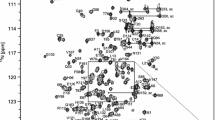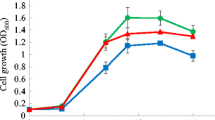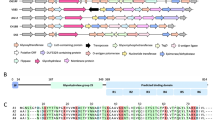Abstract
To fully utilize carbohydrates from seaweed biomass, the degradation of the family of polysaccharides known as alginates must be understood. A step in the degradation of alginate is the conversion of 4,5-unsaturated monouronates to 4-deoxy-L-erythro-5-hexoseulose catalysed by the enzyme KdgF. In this study BeKdgF from Bacteroides eggerthii from the human gut microbiota has been produced isotopically labelled in Escherichia coli. Here the 1H, 13C, and 15N NMR chemical shift assignment for BeKdgF is reported.
Similar content being viewed by others
Avoid common mistakes on your manuscript.
Biological context
There is a growing demand for new biomass globally. A recent report by EIT Climate-KIC concluded that by 2050 the biomass usage in Europe is expected to increase 70−150%, which current biomass sources cannot sustain (Material Economics 2021). A currently underutilised biomass is seaweed. Seaweed is a fast-growing plant that does not require arable land, fresh water, or fertilizer (Enquist-Newman et al. 2014). Seaweed therefore has the potential to be a sustainable source of biomass e.g. for the production of chemical commodities, like biofuels. Alginate composes 30−60% of the polysaccharides found in seaweed. Other carbohydrates include mainly mannitol and glucan, which, unlike alginate, can readily be used in current industry (Enquist-Newman et al. 2014).
Alginates are a family of linear polysaccharides found in brown seaweed and bacteria (Gorin and Spencer 1966; Haug et al. 1967). Alginate consists of (1 → 4)-linked β-D-mannuronic acid (M) and its C-5 epimer α-L-guluronic acid (G) arranged in sequences of M, G, or alternating MG blocks (Pawar and Edgar 2012). Alginate is degraded to 4,5-unsaturated monouronates by alginate lyases (Kim et al. 2011). The monouronates are converted to 4-deoxy-L-erythro-hexoseulose uronic acid (DEH), which is reduced to the key metabolite 2-keto-3-deoxygluconate (KDG) by DEH reductase (Preiss and Ashwell 1962). The conversion of monouronates to DEH is catalysed by the enzyme KdgF, a late step of alginate degradation (Hobbs et al. 2016). For understanding the catalytic mechanism and protein dynamics of KdgF further insight is needed.
Methods and experiments
Construct design
Genomic DNA was isolated from a culture of Bacteroides eggerthii DSM 20,697 purchased from Deutsche Samlung von Mikroorganismen und Zellkulturen (Germany) using Microbiome DNA Purification Kit (Invitrogen) according to manufacturer’s specifications. The gene encoding BeKdgF (UniProt: R5JNH6) was amplified using a modified Phusion High-Fidelity DNA polymerase with primers designed for USER cloning (Salomonsen et al. 2014). BeKdgF was cloned into the pET15b-USER vector by the restriction sites Ndel and BamHI, which extended BeKdgF with an N-terminal His-tag (MGSSHHHHHHGS) resulting in 126 amino acid residues in total, and the full-length construct was used for the resonance assignment. The resulting plasmid (pET15b-USER-BeKdgF) was verified by sequencing (GATC Biotech, Germany).
Sample preparation
For resonance assignment 15N–13C-labelled BeKdgF from B. eggerthii was produced by recombinant expression in Escherichia coli.
E. coli T7 Express cell (New England bioLabs; BL21 (DE3)) transformed with the pET15b-USER-BeKdgF plasmid were incubated overnight (37 °C) in a petri dish containing LB medium (10 g/L tryptone, 5 g/L yeast extract, 5 g/L NaCl), agar (1.5%) and ampicillin (100 μg/mL). One colony was transferred to LB medium (25 mL) containing ampicillin (100 μg/mL) and incubated overnight (30 °C, 225 rpm). The preculture (1% v/v) was added to M9 medium (500 mL, 6 g/L Na2HPO4, 3 g/L KH2PO4, 0.5 g/L NaCl, 1.0 g/L (15NH4)2SO4) along with ampicillin (100 μg/mL), 2 mL MgSO4 (1 M), Trace Metal solution (0.1 g/L ZnSO4, 0.8 g/L MnSO4, 0.5 g/L FeSO4, 0.1 g/L CuSO4, 1 g/L CaCl2), Gibco™ MEM vitamin solution (100x), 10 mL Bioexpress Cell Growth Media (13C, 15 N labelled) (Cambridge Isotope Laboratories), and 6.0 g/L 13C6 D-glucose. All isotopes were purchased from Cambridge Isotope Laboratories, Tewksbury, USA. The culture was incubated (30 °C, 225 rpm) until OD600nm was between 0.6 and 0.8, and the culture was then cooled on ice for 5 min. Expression was induced by adding IPTG (isopropyl β-D-1-thiogalactopyranoside) (final conc. 0.5 mM), hereafter the culture was incubated overnight (16 °C, 190 rpm).
The cells were harvested by centrifugation (10 min, 4 °C, 5000×g), the supernatant was discarded, and the pellet resuspended in ice cold lysis buffer (50 mM HEPES, 300 mM NaCl, pH 7.7) along with one cOmplete™ EDTA-free protease inhibitor tablet (Roche). The resuspended cells were lysed using sonication for 10 min. using a Branson Sonifier equipped with a microtip. The cell lysate was centrifuged (30 min, 4 °C, 16000×g) and the supernatant sterile filtered (0.22 μm filter).
BeKdgF was purified with affinity chromatography using Ni2+-resin. A column was filled with 3 mL cOmplete His-tag Purification Resin (Roche), and the resin was first rinsed with ethanol (20%, 20 mL) and ultrapure water (20 mL), before being equilibrated with 20 mL lysis buffer. The lysate was loaded onto the column and the column was washed with lysis buffer (3 × 7.5 mL) and washing buffer (50 mM HEPES, 300 mM NaCl, 20 mM imidazole, pH 7.7, 8 × 7.5 mL). The protein was eluded using elution buffer (50 mM HEPES, 300 mM NaCl, 300 mM imidazole, pH 7.7) and stored at 4 °C. The enzyme molecular size and purity were assessed using SDS-PAGE.
The buffer was exchanged to the buffer used for NMR data collection (25 mM Na2HPO4, 50 mM NaCl, pH 7.2) using a VivaSpin column (5 kDa cut-off, Sartorius) and the sample was then concentrated to a volume of ≈ 130 μL on an Amicon Ultra centrifugal filter (3 kDa cut-off). The concentrated protein sample was transferred to a 3 mm NMR tube and 99.9% D2O (10 v/v%) (Sigma Aldrich) was added. The BeKdgF concentration in the NMR sample was calculated to 430 μM using an extinction coefficient of 10,095 M−1 cm−1 (Gasteiger et al. 2005) and measuring absorbance at 280 nm (NanoDrop One Microvolume UV–Vis spectrophotometer, Thermo Fisher Scientific). The N-terminal His-tag did not interfere negatively the NMR work thus removal of the His-tag was not attempted.
NMR experiments
All NMR spectra were recorded at 20 °C on a Bruker Avance III HD 800 MHz spectrometer using a 5 mm Z-gradient CP-TCI (H/C/N) cryogenic probe at the NV-NMR-Center/Norwegian NMR Platform (NNP) at the Norwegian University of Science and Technology (NTNU). 1H signals were internally referenced to the water signal, and 13C and 15N signals were indirectly referenced to the water signal based on absolute frequency ratios (Zhang et al. 2003).
Backbone and side-chain resonance assignment were accomplished using 1H–15N HSQC, 1H–13C HSQC, HNCO, HNcaCO, HNCA, HNCACB. HNcoCACB, HNcoHAHB, HNHA, HcCH-TOCSY, and 15 N-NOESY-HSQC with 80 ms mixing time. All spectra were processed using TopSpin version 3.6.1.
Spectra were analysed using CARA (Computer Aided Resonance Assignment) version 1.8.4.2 (Keller 2004). A dihedral angle analysis based on the measured backbone and side-chain chemical shifts was made using TALOS-N (Shen and Bax 2013).
Assignment and data deposition
Here we report the backbone and side-chain assignment of BeKdgF from B. eggerthii. The 15N-HSQC spectrum of BeKdgF with the assigned resonances is shown in Fig. 1. The backbone assignment is almost complete (HN, Hα, Cα, N, and C′ > 92%). The five unassigned residues (H52, F53, P86, D87, and V88) define short two sections in BeKdgF, which may be ascribed to multiple conformations in intermediate exchange, enhance relaxation or fast exchange regime. The side-chain assignment is partially complete (side-chain H and C ≈ 59.3%). The unassigned smaller peaks in the 1H–15N HSQC are due to impurities of the sample. The amino acid residue R108 has an unusual chemical shift as the HN, Cβ, and Hβ chemical shifts are significantly lower than expected (Ulrich et al. 2008). The chemical shifts have been deposited in the Biological Magnetic Resonance Data Bank (BMRB) under the accession number 51288.
1H–15N HSQC spectrum of 13C–15N-labelled BeKdgF from Bacteroides eggerthii in a NaH2PO4 buffer at pH 7.2 with 50 mM NaCl in 90% H2O/10% D2O. Side-chain resonances of Asn and Gln residues are connected by lines. Other side-chain resonances are indicated with the amino acid number and “s.c.”. Residue number and type of backbone and side-chain amide N and HN are indicated
Secondary structural propensity was evaluated by investigating secondary chemical shift values of BeKdgF. The chemical shift deviations of Cα and Cβ from the random-coil values for each residue (Wishart et al. 1995) were calculated, and the results can be seen in Fig. 2. Generally, the Cα chemical shifts of BeKdgF are lower than the predicted random-coil values, whereas the Cβ values are higher. This indicates that BeKdgF generally consists of β-sheets.
Chemical shift deviation from random-coil values (Wishart et al. 1995) for Cα (top) and Cβ (bottom) of BeKdgF
The probability of secondary structural elements was calculated based on the dihedral angle analysis using TALOS-N (Shen and Bax, 2013). The results can be seen in Fig. 3. The dihedral angle analysis shows that 50% of the amino acid residues in BeKdgF form β-strands and the rest random coils with a possibility of a three amino acid residue α-helix present. The β-sheets content is consistent with the three previously reported structures of KdgF from the organisms Yersinia enterocolitica and Halomonas sp (Hobbs et al. 2016).
Results from TALONS-N (Shen and Bax 2013). The panel shows the probability of an amino acid residue adopting a specific secondary structure (red = α-helix, blue = β-strand)
The 1H, 13C, 15N resonance assignment of BeKdgF has been presented. The assignment gives the possibility of further investigation of BeKdgF with NMR spectroscopy. Future functional studies will include metal ion interactions, pH titration, and protein dynamics. Understanding the biological role of KdgF can aid the industrial use of alginates extracted from seaweed as biomass.
Data availability
The assigned chemical shifts have been deposited in the Biological Magnetic Resonance Data Bank (BMRB) under the accession number 51288.
References
Enquist-Newman M et al (2014) Efficient ethanol production from brown macroalgae sugars by a synthetic yeast platform. Nature 505(7482):239–243. https://doi.org/10.1038/NATURE12771
Gasteiger E et al (2005) The proteomics protocols handbook. Humana Press, Totowa. https://doi.org/10.1385/1592598900
Gorin PAJ, Spencer JFT (1966) Exocellular alginic acid from Azotobacter Vinelandii. Can J Chem 44(9):993–998. https://doi.org/10.1139/v66-147
Haug A, Larsen B, Smidsrød O (1967) Studies on the sequence of uronic acid residues in Alginic acid. Acta Chem Scandi 21:691–704
Hobbs JK et al (2016) KdgF, the missing link in the microbial metabolism of uronate sugars from pectin and alginate. Proc Natl Acad Sci USA 113(22):6188–6193. https://doi.org/10.1073/pnas.1524214113
Keller R (2004) The computer aided resonance assignment. Goldau, Switzerland C Verlag [Preprint]
Kim HS, Lee C-G, Lee EY (2011) alginate lyase: structure, property, and application. Biotechnol Bioprocess Eng 16:843–851. https://doi.org/10.1007/s12257-011-0352-8
Material Economics (2021) EU biomass use in a net-zero economy—A course correction for EU biomass
Pawar SN, Edgar KJ (2012) Alginate derivatization: a review of chemistry, properties and applications. Biomaterials 33(11):3279–3305. https://doi.org/10.1016/J.BIOMATERIALS.2012.01.007
Preiss J, Ashwell G (1962) Alginic acid metabolism in bacteria: I. Enzymatic formation of unsaturated oligosaccharides and 4-deoxy-i-erythro-5-hexoseulose uronic acid. J Biol Chem 237(2):309–316. https://doi.org/10.1016/S0021-9258(18)93920-7
Salomonsen B, Mortensen UH, Halkier BA (2014) USER-derived cloning methods and their primer design. Methods Mol Biol (clifton, N.J.) 1116:59–72. https://doi.org/10.1007/978-1-62703-764-8_5
Shen Y, Bax A (2013) Protein backbone and sidechain torsion angles predicted from NMR chemical shifts using artificial neural networks. J Biomol NMR 56(3):227–241. https://doi.org/10.1007/s10858-013-9741-y
Ulrich EL et al (2008) BioMagResBank. Nucleic Acids Res 36(1):D402–D408. https://doi.org/10.1093/NAR/GKM957
Wishart D et al (1995) 1H, 13C and 15N random coil NMR chemical shifts of the common amino acids. I. Investigations of nearest-neighbor effects. J Biomol NMR 5(1):67–81. https://doi.org/10.1007/BF00227471
Zhang H, Neal S, Wishart DS (2003) RefDB: a database of uniformly referenced protein chemical shifts. J Biomol NMR 25(3):173–195. https://doi.org/10.1023/A:1022836027055
Acknowledgements
We are grateful to Christian Dybdahl Andersen for identifying the BeKdgF gene and Kari F. P. Sollerud for optimising the isotope protein production and NMR conditions. Support from Innovation Fund Denmark grant 1308-00011B (StrucSat) and PhD fellowships from Technical University of Denmark (to EGPS and MER) is gratefully acknowledged.
Funding
Open access funding provided by NTNU Norwegian University of Science and Technology (incl St. Olavs Hospital - Trondheim University Hospital). This work was financed by the Norwegian Research Council (NFR) Grants 315385 (AlgModE) and 226244 (Norwegian NMR Platform) and Innovationsfonden (Grant No: 1308-00011B)
Author information
Authors and Affiliations
Contributions
ABP has designed experiments, performed research and analyzed data, and wrote the first draft of the manuscript. IAC, MER, EGPS, DT has performed research, analyzed data, and reviewed the manuscript. BS and F.L.A. initiated the research, conceptualization, designed experiments, analyzed data, edited the manuscript, carried out supervision, and acquired funding.
Corresponding author
Ethics declarations
Conflict of interest
The authors declare that they have no conflict of interest.
Ethical approval
The experiments conducted do not violate any ethical principles.
Consent for publication
All authors declare that they consent to the publication of this paper.
Additional information
Publisher's Note
Springer Nature remains neutral with regard to jurisdictional claims in published maps and institutional affiliations.
Rights and permissions
Open Access This article is licensed under a Creative Commons Attribution 4.0 International License, which permits use, sharing, adaptation, distribution and reproduction in any medium or format, as long as you give appropriate credit to the original author(s) and the source, provide a link to the Creative Commons licence, and indicate if changes were made. The images or other third party material in this article are included in the article's Creative Commons licence, unless indicated otherwise in a credit line to the material. If material is not included in the article's Creative Commons licence and your intended use is not permitted by statutory regulation or exceeds the permitted use, you will need to obtain permission directly from the copyright holder. To view a copy of this licence, visit http://creativecommons.org/licenses/by/4.0/.
About this article
Cite this article
Petersen, A.B., Christensen, I.A., Rønne, M.E. et al. 1H, 13C, 15N resonance assignment of the enzyme KdgF from Bacteroides eggerthii. Biomol NMR Assign 16, 343–347 (2022). https://doi.org/10.1007/s12104-022-10102-6
Received:
Accepted:
Published:
Issue Date:
DOI: https://doi.org/10.1007/s12104-022-10102-6







